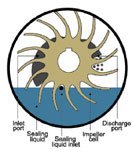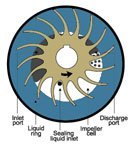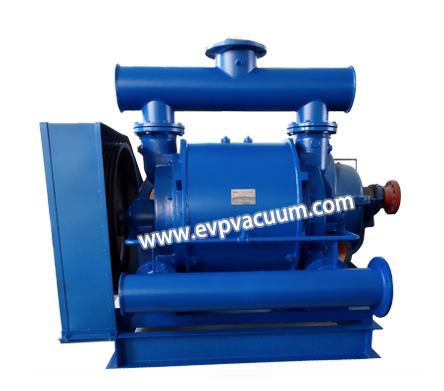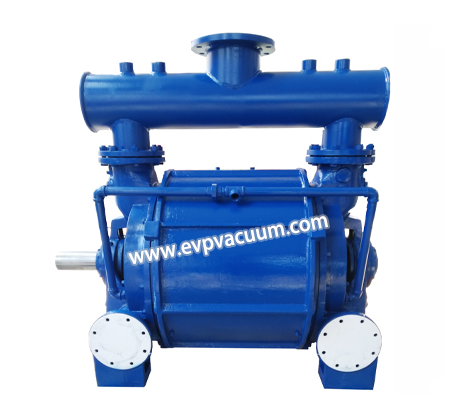API liquid ring vacuum pump
The API liquid ring vacuum pump has an impeller whose blades are fixed on the central hub. The blade is inside the cylinder, but off-center.
See below picture, you can see that the vanes near the top of the pump are closer to the outer wall than the sides and bottom of the pump, more details can be found in this below picture.


The impeller is located between the two end plates (port plates), and the two end plates have shaped holes called holes.
The pump needs liquid (also called a sealant) to create a vacuum, as described below. Before starting the pump, the liquid sealant should be partially filled. Depending on the application, the liquid can be water (making it a water ring vacuum pump), oil or solvent.
The circulation of a single-stage liquid ring vacuum pump:
When the pump is first started, centrifugal force throws the liquid sealant from the impeller to the outer wall of the main body. This forms a liquid ring on the outside of the body. Some blades are completely submerged in liquid, while others are almost submerged in liquid due to the offset design. The space between the liquid (hence the “sealant”) and the impeller blades is sealed. This area is called the “impeller unit”.
Follow an impeller unit from the top of the pump counterclockwise, and you can see the liquid flowing out of the center hub. The sealant acts as a liquid piston to create a larger unit. This is the suction of the pump because it sucks in air, gas or steam through the “inlet” on the side of the impeller. After the impeller unit passes through the inlet and flows to the outlet, the sealing liquid is forced to return to the central hub of the impeller. This will create a compression step.
When the impeller chamber passes through the discharge port, since the volume of the impeller chamber is the smallest, the compression reaches the highest. The gas is discharged to atmospheric pressure through the discharge port together with some liquid sealant. Although these figures show a very smooth liquid ring, in reality, the liquid sealant is highly turbulent. This causes some of the liquid sealant to escape with the gas.

Single-stage liquid ring vacuum pump and two-stage liquid ring vacuum pump:
The cycle of a single-stage liquid ring vacuum pump is described above. With one rotation, we have suction (vacuum) and compression (return to the atmosphere). Some manufacturers’ single-stage liquid ring vacuum pumps can operate up to 26″ HgV, while other manufacturers can operate at 28″ HgV. Some can even be pulled down to 29 inches of mercury. A two-stage liquid ring vacuum pump is designed, just like there are two single-stage liquid ring vacuum pumps connected in series. The discharge from the first stage enters the suction port of the second stage. Compared with single-stage pumps, two-stage liquid ring vacuum pumps have higher efficiency at higher vacuum levels (above 23 inches of mercury), and are designed to operate at vacuum levels higher than 20 inches HgV.
If you want to process solvents under higher vacuum (above 23 inches of mercury pressure), a two-stage liquid ring vacuum pump is also a better choice. This is related to the distribution of the influence of the temperature increase of the sealant in two stages, and it is related to the relationship between the vapor pressure of the sealant in the liquid ring vacuum pump.

Solvent sealed liquid ring vacuum pump
Liquid ring liquid ring vacuum pumps can use any liquid compatible with the process as the sealant liquid, as long as it has appropriate vapor pressure characteristics. The most common sealant is water. However, almost any solvent can be used. The second most common type of sealant is engine oil. The ability to use any liquid makes liquid ring vacuum pumps ideal for solvent recovery. For example, if the application of a vacuum dryer is to dry toluene, then we can use toluene as a sealant. We can recover up to 99% of the solvent for reuse. In fact, EVP vacuum pump has designed and provided a sealed solvent-sealed liquid ring vacuum pump with the following sealing materials:
Alcohol:
Butanol
Ethanol
Isopropyl alcohol (IPA)
Methanol
Other solvents:
Acetonitrile
Decane
DMF
Heptane
Dioctyl phthalate
N-hexane
Isopropyl alcohol (IPA)
Methanol
Tetrahydrofuran
Toluene
The vapor pressure of the sealant is very important to the size of the vacuum system, because it directly affects the capacity of the vacuum pump and the final vacuum. Other compression stages, such as ejectors and superchargers, can be used to exceed the vapor pressure limit of the sealant. In fact, the EVP vacuum pump manufacturer provides a methanol seal system that operates at 5 Torr and a water seal system that operates at 0.03 Torr.
(The article comes from the Internet. If reprinting is not allowed, please contact our company to delete it.)
